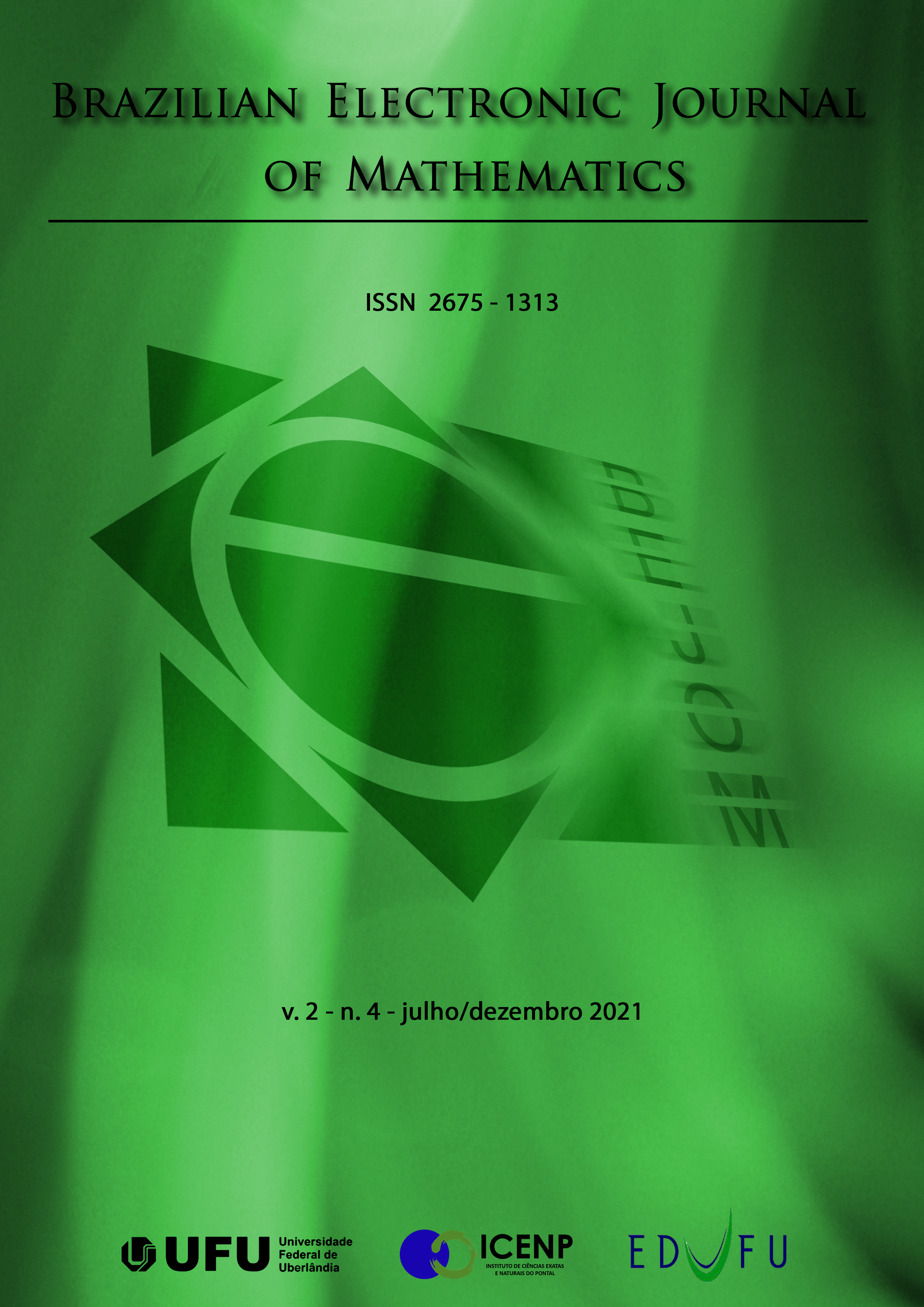Educação algébrica: uso de padrões figurativo-numéricos como recurso didático-pedagógico para os anos finais do ensino fundamental
DOI:
https://doi.org/10.14393/BEJOM-v2-n4-2021-57955Palavras-chave:
Educação Matemática. Pensamento Algébrico. Ensino-aprendizagem. Padrões matemáticos.Resumo
O processo de ensino-aprendizagem de matemática nos anos finais do ensino fundamental é marcado por um histórico de dificuldades. No que tange à educação algébrica, questões relacionadas à interpretação e entendimento da linguagem algébrica são desafios vivenciados durante o processo de escolarização dos estudantes. Neste sentido, este artigo teve por objetivo analisar contribuições da utilização de padrões figurativo-numéricos no segundo ciclo do ensino fundamental. Para tanto, pautados na abordagem qualitativa e na pesquisa bibliográfica, buscamos por estas contribuições, evidenciar diferentes possibilidades de intervenção pedagógica em situações didáticas adversas. Como conclusões, defendemos que a utilização do padrão figurativo-numérico nesta etapa educativa possui potencialidades importantes para a educação algébrica, visando melhor compreensão do corpo discente no que se refere a linguagem algébrica e a representação algébrica de padrões matemáticos ao longo do seu processo de escolarização. Por meio de atividades utilizando tais padrões, revelamos que pode ser possível o resgate de dificuldades matemáticas provenientes de etapas pregressas, uma vez que é possível interligar uma multiplicidade de conteúdos e conceitos, bem como áreas de conhecimento. Desta forma, entendemos que tais ações podem, por sua vez, qualificar a díade ensino-aprendizagem de álgebra na educação básica e, em especial, nos anos finais do ensino fundamental.
Downloads
Referências
BRANCO, N. C. V.O estudo de padrões e regularidades no desenvolvimento do pensamento algébrico. 251 f. Dissertação (Mestrado em Educação) - Departamento de Educação, Faculdade de Ciências, Universidade de Lisboa, Lisboa, Portugal, 2008.
BRASIL. Secretaria de Educação Fundamental. Parâmetros Curriculares Nacionais. Brasília: MEC/SEF, 1998.
BRASIL. Ministério da Educação. Base Nacional Comum Curricular. Brasília: MEC, 2017.
CAVASOTTO, M. Dificuldades na aprendizagem de Cálculo: o que os erros cometidos pelos alunos podem informar. 146 f. Dissertação (Mestrado em Educação em Ciências e Matemática) - Faculdade de Física, Pontifícia Universidade Católica do Rio Grande do Sul. Porto Alegre, 2010.
CRESWELL, J. W. Projeto de pesquisa: métodos quantitativo, qualitativo e misto. Trad. Magda França Lopes. 3. ed. Porto Alegre: Artmed, 2010.
DEVLIN, K. Matemática: a ciência dos padrões. Porto: Editora Porto, 2002.
FIORENTINI, D.; LORENZATO, S. Investigação em Educação Matemática: percursos teóricos e metodológicos. Campinas, SP: Autores Associados, 2006. (Coleção Formação de Professores).
GIL, K. H.Reflexões sobre as dificuldades dos alunos na aprendizagem de Álgebra.118 f. Dissertação (Mestrado em Educação em Ciências e Matemática) - Faculdade de Física, Pontifícia Universidade Católica do Rio Grande do Sul, Porto Alegre, 2008.
HANKE, T. A. F. Padrões de regularidades: uma abordagem no desenvolvimento do pensamento algébrico. 212 f. Dissertação (Mestrado em Ensino de Ciências e Matemática) - Pontifícia Universidade Católica de Minas Gerais, Belo Horizonte, 2008.
MODANEZ, L. Das seqüências de padrões geométricos à introdução ao pensamento algébrico. 93 f. Dissertação (Mestrado em Educação Matemática) - Pontifícia Universidade Católica de São Paulo, São Paulo, 2003.
PEREZ, Elisangela Parra Zigart. Alunos do Ensino Médio e a generalização de padrão. PUC - São Paulo, 2006 (Dissertação de mestrado).
PRODANOV, C. C.; FREITAS, E. C. Metodologia do trabalho científico: métodos e técnicas de pesquisa e do trabalho acadêmico. 2. ed. Novo Hamburgo: Feevale, 2013.
SANTOS, G. M. T. O comprometimento do estudante e a aprendizagem em Cálculo Diferencial e Integral I. 217 f. Dissertação (Mestrado Acadêmico em Educação) - Universidade La Salle, Canoas, 2014.
VALE, I.; PIMENTEL, T. Padrões: um tema transversal do currículo. Revista da Associação de Professores de Matemática. No 85, novembro/dezembro, 2005.
Downloads
Publicado
Edição
Seção
Licença
Copyright (c) 2021 BRAZILIAN ELECTRONIC JOURNAL OF MATHEMATICS

Este trabalho está licenciado sob uma licença Creative Commons Attribution-NonCommercial 4.0 International License.
- Os artigos publicados a partir de 2025 são licenciados sob a versão CCBY-4.0. Ao enviar o material para publicação, os autores estarão automaticamente, concordando com as diretrizes editoriais do periódico e assumindo que o texto foi devidamente revisado. A submissão simultânea de artigos a outras revistas é proibida, e, é também proibida a tradução de artigos publicados no periódico para outro idioma sem a devida autorização.
- Os artigos publicados em anos anteriores a 2025 são licenciados sob a versão CC BY-NC 4.0.









